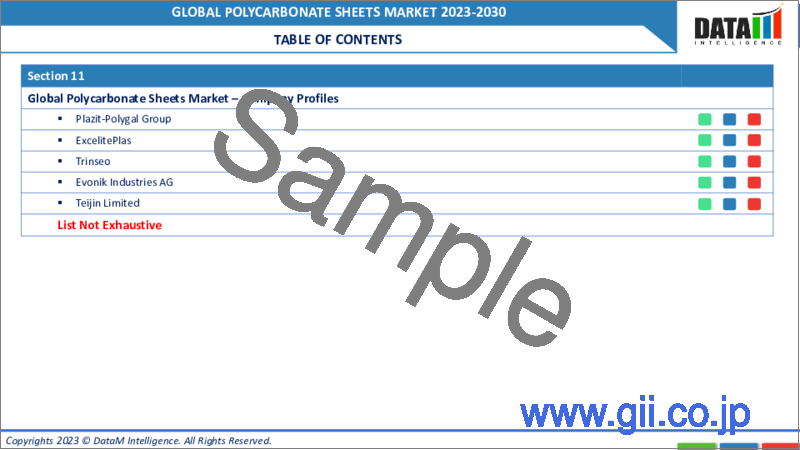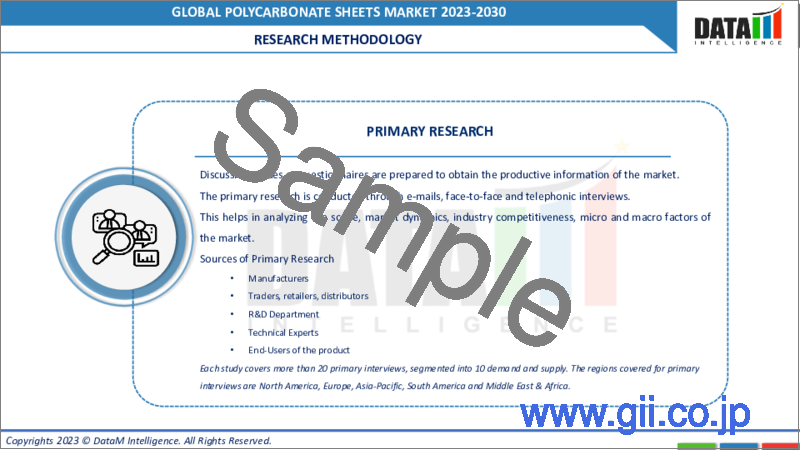|
|
市場調査レポート
商品コード
1304551
ポリカーボネートシートの世界市場-2023年~2030年Global Polycarbonate Sheet Market - 2023-2030 |
||||||
カスタマイズ可能
適宜更新あり
|
|||||||
| ポリカーボネートシートの世界市場-2023年~2030年 |
|
出版日: 2023年07月07日
発行: DataM Intelligence
ページ情報: 英文 183 Pages
納期: 即日から翌営業日
|
- 全表示
- 概要
- 目次
市場概要
世界のポリカーボネートシート市場は、2022年に16億米ドルに達し、2023-2030年の予測期間中にCAGR 5.7%で成長し、2030年には24億米ドルに達すると予測されています。世界のポリカーボネートシート市場は、主に建設、自動車、エレクトロニクス、パッケージングなどの産業からの需要増加に後押しされ、近年大きな成長を遂げています。
特に建設セクターは、市場拡大の大きな起爆剤として浮上しています。ポリカーボネートシートの世界市場では、アジア太平洋地域が市場シェアの4分の1以上を占めています。同地域は人口が多く、可処分所得が高く、建設と自動車セクターが堅調に成長していることが、同市場の大きな存在感につながっています。
アジア太平洋地域では、環境に優しい代替品への需要や、世界の動向に沿った持続可能な建設慣行の採用が追い風となり、ポリカーボネートシート分野における市場機会が急増し、積極的な参入が見られるようになっています。さらに、ポリカーボネートシート市場では、固形ポリカーボネートシートセグメントが市場全体の約3分の2を占め、大半のシェアを占めています。
この優位性は、ポリカーボネートシートが他の製品よりも固形ポリカーボネートシートが好まれていることを反映しています。まとめると、世界のポリカーボネートシート市場は、継続的なインフラ開拓、自動車技術革新、技術先進、持続可能なパッケージングの重視の高まりなどを背景に、メーカーやサプライヤーにとって有望な市場機会を提供しています。
市場力学
多様な用途と各業界におけるメリット
ポリカーボネートシートは、CD、DVD、ブルーレイディスクなどの光ディスクの製造に広く使用されています。また、温室製造、暴動防止具の製造、刑務所の窓ガラスなど、様々な分野で使用されています。しかし、その人気は建築・建設業界で特に顕著です。ポリカーボネートシートは高度な技術的特徴を持ち、明るさと均一性の優れた組み合わせを提供します。
高品位ポリカーボネートシートは、LEDに滑らかな表面を提供し、ホットスポットをなくし、明るい環境を作るために一般的に採用されています。ポリカーボネートシート市場は、耐衝撃性や耐熱性、長寿命、優れた断熱性、光拡散、UVカット、設置の容易さなど、さまざまな有利な特性により、大幅な投資が見込まれています。前述の特性により、ポリカーボネートシートはエネルギー効率の高いLED照明技術に最適です。
技術革新と持続可能性への高まり
ポリカーボネートシートの世界市場の成長を後押ししているのは、大幅な技術進歩とイノベーションです。このような進歩により、特性が強化された新製品がイントロダクションされ、ポリカーボネートシートの用途が拡大しています。
例えば、米国国立標準技術研究所(NIST)は、自己修復性ポリカーボネートシートの開発で大きな進展があったことを報告しています。前述のシートは、軽微な損傷や傷を修復し、寿命を延ばし、メンテナンスコストを削減することができます。
また、ポリカーボネートシートの世界市場では、持続可能性が大きな原動力となっています。世界各国の政府は、産業が環境に与える影響を最小限に抑え、エネルギー効率を向上させるため、環境に優しい素材の使用を積極的に推進しています。
例えば欧州連合(EU)は2020年に「循環経済行動計画」を導入し、製造分野におけるリサイクル性と資源効率の重要性を強調しています。リサイクル可能で長持ちするポリカーボネートシートは、こうした持続可能性の目標に合致しており、さまざまな産業分野での採用が進んでいます。
環境負荷の増大と原料価格変動の増大
ポリカーボネートシートは、その優れた特性と多様な用途にもかかわらず、ビスフェノールAの存在により環境面で懸念があり、食品産業用途には適さないです。さらに、その非生分解性という性質が、環境に重大な危険をもたらしています。ポリカーボネートシートは、CD、DVD、自動車部品、屋根材の製造に使用されています。ポリカーボネートシートの廃材を川や海に不適切に廃棄すると、海洋生物に大きな脅威を与えます。
さらに、ポリカーボネートシートを使用した最終製品の価格は、原材料、特に原油の入手可能性とコストの影響を受ける。近年の原油価格の変動は、ポリカーボネートシートの価格に影響を与えています。ポリカーボネートシートのメーカーは、価格に敏感な消費者や輸入リスクに関する課題に直面しています。
COVID-19の影響分析
COVID-19は世界のサプライチェーンに大きな混乱をもたらし、ポリカーボネートシートの生産と供給力に影響を与えました。製造工場は、世界各国の政府による操業停止や制限により、一時的な閉鎖や生産能力の低下に直面しました。この混乱により、生産の遅れ、原材料の不足、物流の課題などが生じ、ポリカーボネートシートの供給全体に影響を及ぼしました。
例えば、中国はポリカーボネートシートの主要生産国・輸出国として、2020年上半期に大幅な生産減に見舞われました。工場の閉鎖、労働力の減少、交通機関の乱れにより、生産量は前年比でほぼ1/5に減少しました。
COVID-19の大流行も、主要な最終用途産業におけるポリカーボネートシートの需要減少につながっています。ポリカーボネートシート市場の大部分を占める建設業界では、規制や経済の不確実性により減速やプロジェクトの遅れが発生しました。
ポリカーボネートシートのもう一つの主要な消費者である自動車産業は、パンデミックの間、生産と販売の減少を目の当たりにしました。しかし、世界がパンデミックから徐々に回復するにつれて、ポリカーボネートシート市場は、建設活動の再開、自動車生産の増加、ヘルスケアインフラへの継続的な投資によって、回復すると予想されます。
目次
第1章 調査手法と調査範囲
第2章 定義と概要
第3章 エグゼクティブサマリー
第4章 市場力学
- 影響要因
- 促進要因
- 持続可能性と技術革新に対する需要の高まり
- 建築・自動車産業におけるポリカーボネートシートの用途拡大
- 多目的な用途と各業界におけるメリット
- 技術革新と持続可能性への高まり
- 抑制要因
- 環境負荷の増大と原料価格変動の増大
- 原材料価格の変動と環境への懸念
- 機会
- 影響分析
- 促進要因
第5章 産業分析
- ポーターのファイブフォース分析
- サプライチェーン分析
- 価格分析
- 規制分析
第6章 COVID-19分析
第7章 タイプ別
- 固体
- マルチウォール
- コルゲート
第8章 エンドユーザー別
- 建築・建設
- 自動車・輸送
- 電気・電子
- その他
第9章 地域別
- 北米
- 米国
- カナダ
- メキシコ
- 欧州
- ドイツ
- 英国
- フランス
- イタリア
- ロシア
- その他欧州
- 南米
- ブラジル
- アルゼンチン
- その他南米
- アジア太平洋
- 中国
- インド
- 日本
- オーストラリア
- その他アジア太平洋地域
- 中東・アフリカ
第10章 競合情勢
- 競合シナリオ
- 市況/シェア分析
- M&A分析
第11章 企業プロファイル
- Teijin Limited
- 会社概要
- 製品ポートフォリオと説明
- 財務概要
- 最近の動向
- SABIC
- Covestro AG
- Mitsubishi Gas Chemical Company, Inc
- Suzhou Omay Optical Materials Co, Ltd
- 3A Composites GmbH
- Plazit-Polygal Group
- Excelite
- Trinseo
- Evonik Industries AG
第12章 付録
Market Overview
The Global Polycarbonate Sheet Market reached US$ 1.6 billion in 2022 and is expected to reach US$ 2.4 billion by 2030, growing with a CAGR of 5.7% during the forecast period 2023-2030. The global polycarbonate sheet market has experienced significant growth in recent years, primarily fueled by the increasing demand from industries such as construction, automotive, electronics, and packaging.
The construction sector, in particular, has emerged as a major catalyst for the market's expansion. Asia-Pacific is a prominent region in the global polycarbonate sheet market, accounting for more than a quarter of the market share. The region's large population, high disposable incomes, and robust growth in the construction and automotive sectors contribute to its significant market presence.
Asia-Pacific has witnessed a surge in market opportunities and active participation in the polycarbonate sheet segment, driven by the demand for eco-friendly alternatives and the adoption of sustainable construction practices, in line with global trends. Furthermore, within the polycarbonate sheet market, the solid polycarbonate sheet segment holds the majority market share, accounting for almost two-thirds of the total market.
The respective dominance reflects the preference for solid polycarbonate sheets over other variants. In summary, the global polycarbonate sheet market presents promising market opportunities for manufacturers and suppliers, driven by ongoing infrastructure development, automotive innovations, technological advancements, and the growing emphasis on sustainable packaging practices.
Market Dynamics
Versatile Applications and the Benefits they Offer Across Industries
Polycarbonate sheets are widely used to manufacture optical disks, including CDs, DVDs, and Blu-ray Discs. The material also find applications in diverse sectors, such as greenhouse manufacturing, anti-riot gear production, and prison windows. However, their popularity is particularly significant in the building and construction industry. Polycarbonate sheets offer advanced technical features, delivering an excellent combination of brightness and uniformity.
The high-grade polycarbonate sheets are commonly employed to provide a smooth surface for LEDs, ensuring no hot spots and creating a brighter environment. The polycarbonate sheet market is expected to witness substantial investments due to its various advantageous properties, including impact and heat resistance, extended lifespan, superior insulation, light diffusion, UV protection, and ease of installation. The aforementioned properties make polycarbonate sheets ideal for energy-efficient LED lighting technology.
Technological Innovations and the growing transition toward sustainability
Significant technological advancements and innovations have fueled the growth of the global polycarbonate sheet market. Such advances have resulted in the introduction of new product variants that offer enhanced properties, thereby expanding the range of applications for polycarbonate sheets.
For example, the National Institute of Standards and Technology (NIST) in U.S. has reported significant progress in the development of self-healing polycarbonate sheets. The aforementioned sheets can repair minor damages and scratches, increasing their longevity and reducing maintenance costs.
In addition, sustainability has emerged as a major driving force in the global polycarbonate sheet market. Governments worldwide are actively promoting the use of environmentally friendly materials to minimize the industry's environmental impact and improve energy efficiency.
The European Union, for instance, introduced the Circular Economy Action Plan in 2020, which emphasizes the importance of recyclability and resource efficiency in the manufacturing sector. Polycarbonate sheets, being recyclable and long-lasting, align with these sustainability objectives, driving their adoption across various industries.
Growing Environmental Impact and Increasing Fluctuation in Raw Material Prices
Despite their excellent properties and diverse applications, polycarbonate sheets face environmental concerns due to the presence of bisphenol A, making them unsuitable for food industry applications. Furthermore, their non-biodegradable nature poses a significant environmental hazard. Polycarbonate sheets find use in the production of CDs, DVDs, vehicle parts, and roofing systems. Improper disposal of polycarbonate sheet waste materials in rivers or oceans poses a significant threat to marine life.
Additionally, the prices of end goods incorporating polycarbonate sheets are influenced by the availability and cost of raw materials, particularly crude oil. The volatility of crude oil prices in recent years has had an impact on the prices of polycarbonate sheets. Manufacturers of polycarbonate sheets face challenges related to price-sensitive consumers and import risks.
COVID-19 Impact Analysis
COVID-19 led to significant disruptions in global supply chains, affecting the production and availability of polycarbonate sheets. Manufacturing plants faced temporary closures and reduced capacity due to lockdowns and restrictions imposed by governments globally. The disruption resulted in delayed production, shortage of raw materials, and logistical challenges, impacting the overall supply of polycarbonate sheets.
For instance , China experienced a significant decline in production during the first half of 2020 as a major producer and exporter of polycarbonate sheets. Factory closures, reduced workforce, and disrupted transportation contributed to a decrease in output by almost 1/5th compared to the previous year.
The COVID-19 pandemic also resulted in reduced demand for polycarbonate sheets in key end-use industries. The construction sector, which accounts for a significant portion of the polycarbonate sheet market, experienced slowdowns and project delays due to restrictions and economic uncertainties.
The automotive industry, another major consumer of polycarbonate sheets, witnessed a decline in production and sales during the pandemic. However, as the world gradually recovers from the pandemic, the polycarbonate sheet market is expected to rebound, driven by the resumption of construction activities, increased automotive production, and ongoing investments in healthcare infrastructure.
Segment Analysis
The Global Polycarbonate Sheet Market is segmented based on type, end-user and region.
Product advancements and a wide range of applications contributed to its dominance of multi-walled polycarbonate sheets
The multi-walled segment has emerged as a dominant player in the global polycarbonate sheet market due to its superior properties and versatility. The growth of this segment can be attributed to the construction industry boom and the increasing demand in the automotive sector. Product advancements and a wide range of applications have further contributed to its dominance. Manufacturers of multi-walled polycarbonate sheets have invested significantly in research and development to improve product performance and expand their applications. The respective investments have resulted in the development of advanced materials with superior thermal insulation, UV resistance, and fire-retardant properties, strengthening the dominance of the multi-walled segment.
Further, multi-walled polycarbonate sheets are extensively used in diverse industries, including construction, automotive, agriculture, and electronics. The product's adaptability and versatility have allowed them to dominate the polycarbonate sheet market. The sheets are used for greenhouse roofing, noise barriers, machine guards, signage, and more. For instance, These sheets find application in automotive glazing, including sunroofs, side windows, and windshields. Their lightweight nature and high impact resistance improve fuel efficiency and passenger safety.
Geographical Analysis
Robust construction and automotive sectors coupled with Governmental initiatives to promote energy efficiency and reduced carbon emissions
The Asia-Pacific region has emerged as a leading force in the global polycarbonate sheet market, witnessing significant growth and asserting its dominance. Asia-Pacific's robust construction and automotive sectors have been instrumental in driving the growth of the polycarbonate sheet market in the region.
The demand for polycarbonate sheets, known for their durability, transparency, and lightweight properties, has surged in both industries. Rapid urbanization, infrastructural development, and increased investment in commercial and residential projects have fueled the demand for polycarbonate sheets. Similarly, the automotive industry in Asia-Pacific has experienced substantial growth, with rising disposable incomes and increasing vehicle production.
Moreover, Governments have introduced regulations promoting energy efficiency and reduced carbon emissions. Polycarbonate sheets, known for their insulating properties, light transmission, and recyclability, align well with these environmental goals.
Many countries in the region have implemented building codes and standards that prioritize energy-efficient construction. Polycarbonate sheets are increasingly being used as a sustainable alternative to traditional building materials, facilitating compliance with these standards.
Competitive Landscape
The major global players include: Teijin Limited, SABIC, Covestro AG, Mitsubishi Gas Chemical Company, Inc, Suzhou Omay Optical Materials Co, Ltd, 3A Composites GmbH, Plazit-Polygal Group, Excelite, Trinseo and Evonik Industries AG.
Why Purchase the Report?
- To visualize the Global Polycarbonate Sheet Market segmentation based on product, skill level, target audience, application and region, as well as understand key commercial assets and players.
- Identify commercial opportunities by analyzing trends and co-development.
- Excel data sheet with numerous data points of polycarbonate sheet market-level with all segments.
- PDF report consists of a comprehensive analysis after exhaustive qualitative interviews and an in-depth study.
- Product mapping available as Excel consisting of key products of all the major players.
Why Purchase the Report?
- To visualize the Global Polycarbonate Sheet Market segmentation based on type, end-user and region, as well as understand key commercial assets and players.
- Identify commercial opportunities by analyzing trends and co-development.
- Excel data sheet with numerous data points of polycarbonate sheet market-level with all segments.
- PDF report consists of a comprehensive analysis after exhaustive qualitative interviews and an in-depth study.
- Product mapping available as Excel consisting of key products of all the major players.
The Global Polycarbonate Sheet Market Report Would Provide Approximately 53 Tables, 46 Figures And 183 Pages.
Target Audience 2023
- Manufacturers/ Buyers
- Industry Investors/Investment Bankers
- Research Professionals
- Emerging Companies
Table of Contents
1. Methodology and Scope
- 1.1. Research Methodology
- 1.2. Research Objective and Scope of the Report
2. Definition and Overview
3. Executive Summary
- 3.1. Snippet by Type
- 3.2. Snippet by End-User
- 3.3. Snippet by Region
4. Dynamics
- 4.1. Impacting Factors
- 4.1.1. Drivers
- 4.1.1.1. Growing Demand for Sustainability and Technological Innovations
- 4.1.1.2. Growth in Application of Polycarbonate Sheets in Construction and Automotive Industries
- 4.1.1.3. Versatile Applications and the Benefits they Offer Across Industries
- 4.1.1.4. Technological Innovations and growing transition towrds sustainability
- 4.1.2. Restraints
- 4.1.2.1. Growing Environmental Impact and Increasing Fluctuation in Raw Material Prices
- 4.1.2.2. Volatility in Raw Material Prices and Environmental Concerns
- 4.1.3. Opportunity
- 4.1.4. Impact Analysis
- 4.1.1. Drivers
5. Industry Analysis
- 5.1. Porter's Five Force Analysis
- 5.2. Supply Chain Analysis
- 5.3. Pricing Analysis
- 5.4. Regulatory Analysis
6. COVID-19 Analysis
- 6.1. Analysis of COVID-19
- 6.1.1. Scenario Before COVID
- 6.1.2. Scenario During COVID
- 6.1.3. Scenario Post COVID
- 6.2. Pricing Dynamics Amid COVID-19
- 6.3. Demand-Supply Spectrum
- 6.4. Government Initiatives Related to the Market During Pandemic
- 6.5. Manufacturers Strategic Initiatives
- 6.6. Conclusion
7. By Type
- 7.1. Introduction
- 7.1.1. Market Size Analysis and Y-o-Y Growth Analysis (%), By Type
- 7.1.2. Market Attractiveness Index, By Type
- 7.2. Solid*
- 7.2.1. Introduction
- 7.2.2. Market Size Analysis and Y-o-Y Growth Analysis (%)
- 7.3. Multi-Walled
- 7.4. Corrugated
8. By End-User
- 8.1. Introduction
- 8.1.1. Market Size Analysis and Y-o-Y Growth Analysis (%), By End-User
- 8.1.2. Market Attractiveness Index, By End-User
- 8.2. Building & Construction*
- 8.2.1. Introduction
- 8.2.2. Market Size Analysis and Y-o-Y Growth Analysis (%)
- 8.3. Automotive & Transportation
- 8.4. Electrical & Electronics
- 8.5. Others
9. By Region
- 9.1. Introduction
- 9.1.1. Market Size Analysis and Y-o-Y Growth Analysis (%), By Region
- 9.1.2. Market Attractiveness Index, By Region
- 9.2. North America
- 9.2.1. Introduction
- 9.2.2. Key Region-Specific Dynamics
- 9.2.3. Market Size Analysis and Y-o-Y Growth Analysis (%), By Type
- 9.2.4. Market Size Analysis and Y-o-Y Growth Analysis (%), By End-User
- 9.2.5. Market Size Analysis and Y-o-Y Growth Analysis (%), By Country
- 9.2.5.1. The U.S.
- 9.2.5.2. Canada
- 9.2.5.3. Mexico
- 9.3. Europe
- 9.3.1. Introduction
- 9.3.2. Key Region-Specific Dynamics
- 9.3.3. Market Size Analysis and Y-o-Y Growth Analysis (%), By Type
- 9.3.4. Market Size Analysis and Y-o-Y Growth Analysis (%), By End-User
- 9.3.5. Market Size Analysis and Y-o-Y Growth Analysis (%), By Country
- 9.3.5.1. Germany
- 9.3.5.2. The UK
- 9.3.5.3. France
- 9.3.5.4. Italy
- 9.3.5.5. Russia
- 9.3.5.6. Rest of Europe
- 9.4. South America
- 9.4.1. Introduction
- 9.4.2. Key Region-Specific Dynamics
- 9.4.3. Market Size Analysis and Y-o-Y Growth Analysis (%), By Type
- 9.4.4. Market Size Analysis and Y-o-Y Growth Analysis (%), By End-User
- 9.4.5. Market Size Analysis and Y-o-Y Growth Analysis (%), By Country
- 9.4.5.1. Brazil
- 9.4.5.2. Argentina
- 9.4.5.3. Rest of South America
- 9.5. Asia-Pacific
- 9.5.1. Introduction
- 9.5.2. Key Region-Specific Dynamics
- 9.5.3. Market Size Analysis and Y-o-Y Growth Analysis (%), By Type
- 9.5.4. Market Size Analysis and Y-o-Y Growth Analysis (%), By End-User
- 9.5.5. Market Size Analysis and Y-o-Y Growth Analysis (%), By Country
- 9.5.5.1. China
- 9.5.5.2. India
- 9.5.5.3. Japan
- 9.5.5.4. Australia
- 9.5.5.5. Rest of Asia-Pacific
- 9.6. Middle East and Africa
- 9.6.1. Introduction
- 9.6.2. Key Region-Specific Dynamics
- 9.6.3. Market Size Analysis and Y-o-Y Growth Analysis (%), By Type
- 9.6.4. Market Size Analysis and Y-o-Y Growth Analysis (%), By End-User
10. Competitive Landscape
- 10.1. Competitive Scenario
- 10.2. Market Positioning/Share Analysis
- 10.3. Mergers and Acquisitions Analysis
11. Company Profiles
- 11.1. Teijin Limited*
- 11.1.1. Company Overview
- 11.1.2. Product Portfolio and Description
- 11.1.3. Financial Overview
- 11.1.4. Recent Developments
- 11.2. SABIC
- 11.3. Covestro AG
- 11.4. Mitsubishi Gas Chemical Company, Inc
- 11.5. Suzhou Omay Optical Materials Co, Ltd
- 11.6. 3A Composites GmbH
- 11.7. Plazit-Polygal Group
- 11.8. Excelite
- 11.9. Trinseo
- 11.10. Evonik Industries AG
LIST NOT EXHAUSTIVE
12. Appendix
- 12.1. About Us and Services
- 12.2. Contact Us





